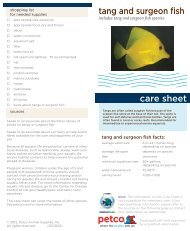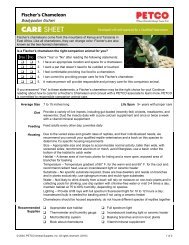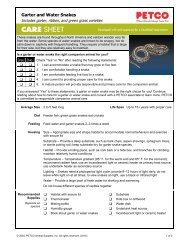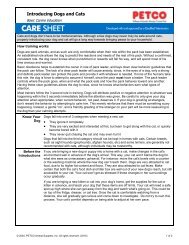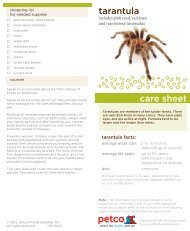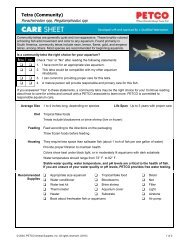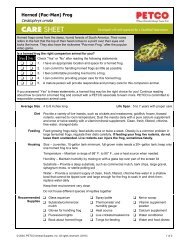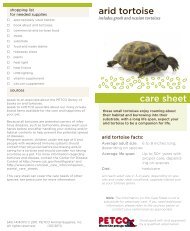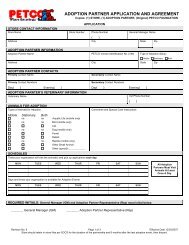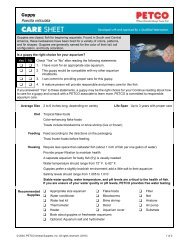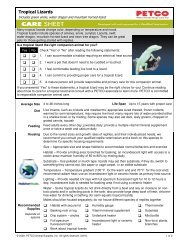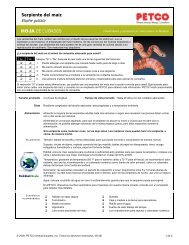Fancy “Black Bear” Hamster - Petco
Fancy “Black Bear” Hamster - Petco
Fancy “Black Bear” Hamster - Petco
Create successful ePaper yourself
Turn your PDF publications into a flip-book with our unique Google optimized e-Paper software.
<strong>Fancy</strong> <strong>“Black</strong> <strong>Bear”</strong> <strong>Hamster</strong><br />
Mesocricetus auratus<br />
Normal<br />
Behavior and<br />
Interaction<br />
Habitat<br />
Maintenance<br />
Grooming<br />
and Hygiene<br />
Signs of a<br />
Healthy Animal<br />
Common<br />
Health Issues<br />
Red Flags<br />
Active during the night and sleep during the day (nocturnal)<br />
Easy to handle but may nip if suddenly awakened from a nap or startled<br />
Chews on objects to maintain the incisor teeth, which grow continuously; ensure have plenty<br />
of chew sticks available<br />
Uses cheek pouches to move food from one location to another<br />
Solitary; never house more than one adult hamster per habitat<br />
Remove wet spots daily; change bedding weekly or more often as needed<br />
Clean the habitat and its contents once a week with mild soap and water, rinse and allow to<br />
dry completely before placing hamster back into the habitat<br />
<strong>Hamster</strong>s stay clean and do not need baths; clean with a damp washcloth or unscented baby<br />
wipes, if necessary<br />
Consult with a veterinarian if a hamster’s teeth or nails seem too long<br />
Because all hamsters are potential carriers of infectious diseases, always wash your hands before and<br />
after handling your hamster and/or the habitat contents to help prevent the potential of spread of<br />
diseases.<br />
Pregnant women and people with weakened immune systems should contact their physician before<br />
purchasing and/or caring for a hamster and should consider not having a hamster as a pet. For more<br />
information regarding hamsters and disease, contact the Center for Disease Control at<br />
http://www.cdc.gov/healthypets/ and PETCO at http://www.petco.com/pet care info/companion animal<br />
care sheets.<br />
• Active, alert, and responsive • Eats and drinks regularly<br />
• Healthy, clean fur and clear eyes • Clear breathing and walks normally<br />
It is normal for a hamster’s teeth to be yellow; cleaning is not necessary<br />
Health Issue Symptoms or Causes Suggested Action<br />
Diabetes Frequent urination and lethargy. Consult with an exotic animal<br />
veterinarian.<br />
Diarrhea Loose stools caused by poor diet, stress,<br />
internal parasites, unclean housing, or<br />
other illness.<br />
If you notice any of these signs, please contact your exotic animal veterinarian.<br />
Sources Choosing a Small Mammal by Dennis Kelsey-Wood<br />
<strong>Hamster</strong>s as a New Pet by Anmarie Barrie<br />
The ASPCA Complete Guide to Pet Care by David L. Carroll<br />
Consult with an exotic animal<br />
veterinarian to determine cause<br />
and treatment.<br />
Malocclusion Overgrown teeth. Consult with an exotic animal<br />
veterinarian to possibly have<br />
teeth trimmed regularly.<br />
Mites External parasite that causes hamsters<br />
to lose patches of hair.<br />
Contact an exotic animal<br />
veterinarian for treatment.<br />
• Weight loss • Abnormal hair loss • Diarrhea or dirty bottom<br />
• Distressed breathing • Lethargic • Eye or nasal discharge<br />
• Skin lesions • Overgrown teeth<br />
Note: The information on this Care Sheet is not a substitute for veterinary care. If you need additional<br />
information, please refer to the above sources or contact your veterinarian as appropriate.<br />
2 of 2 SKU 926337© 2005, PETCO Animal Supplies, Inc. All rights reserved. (0830)



